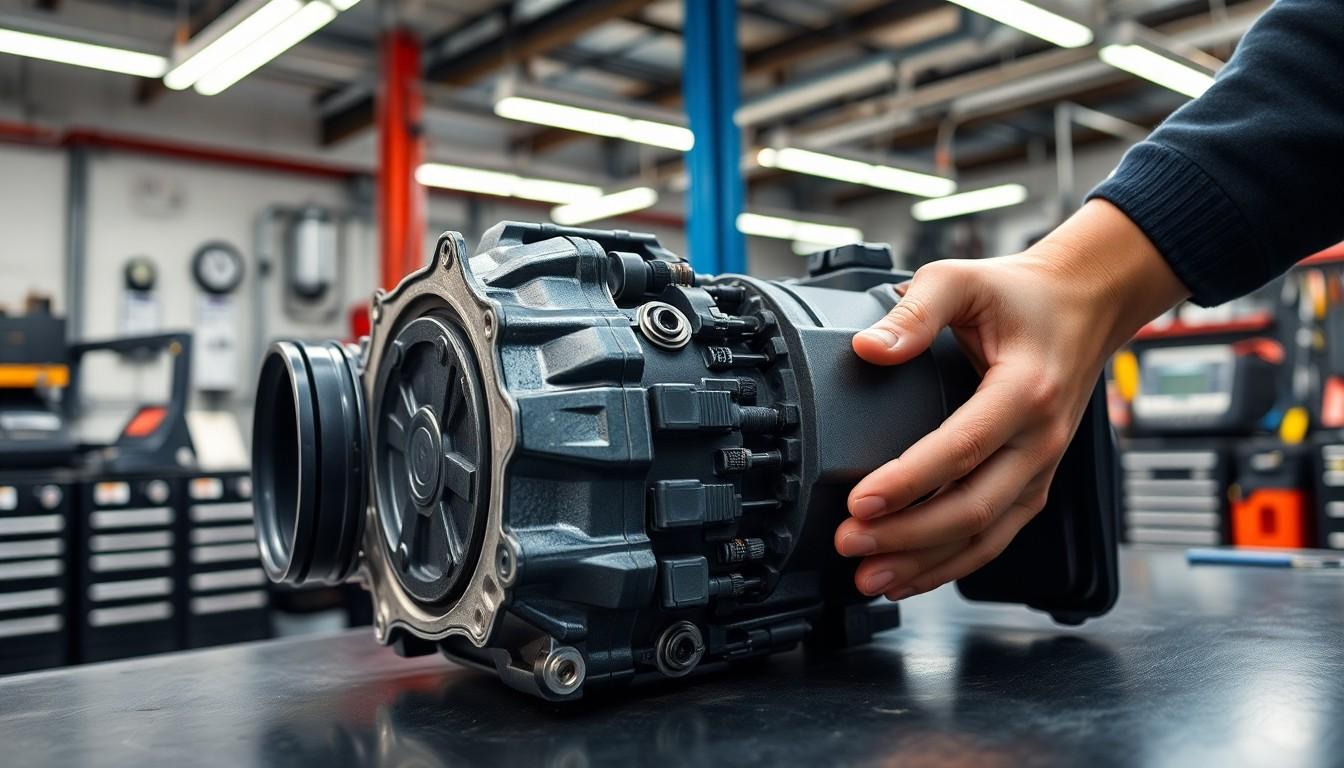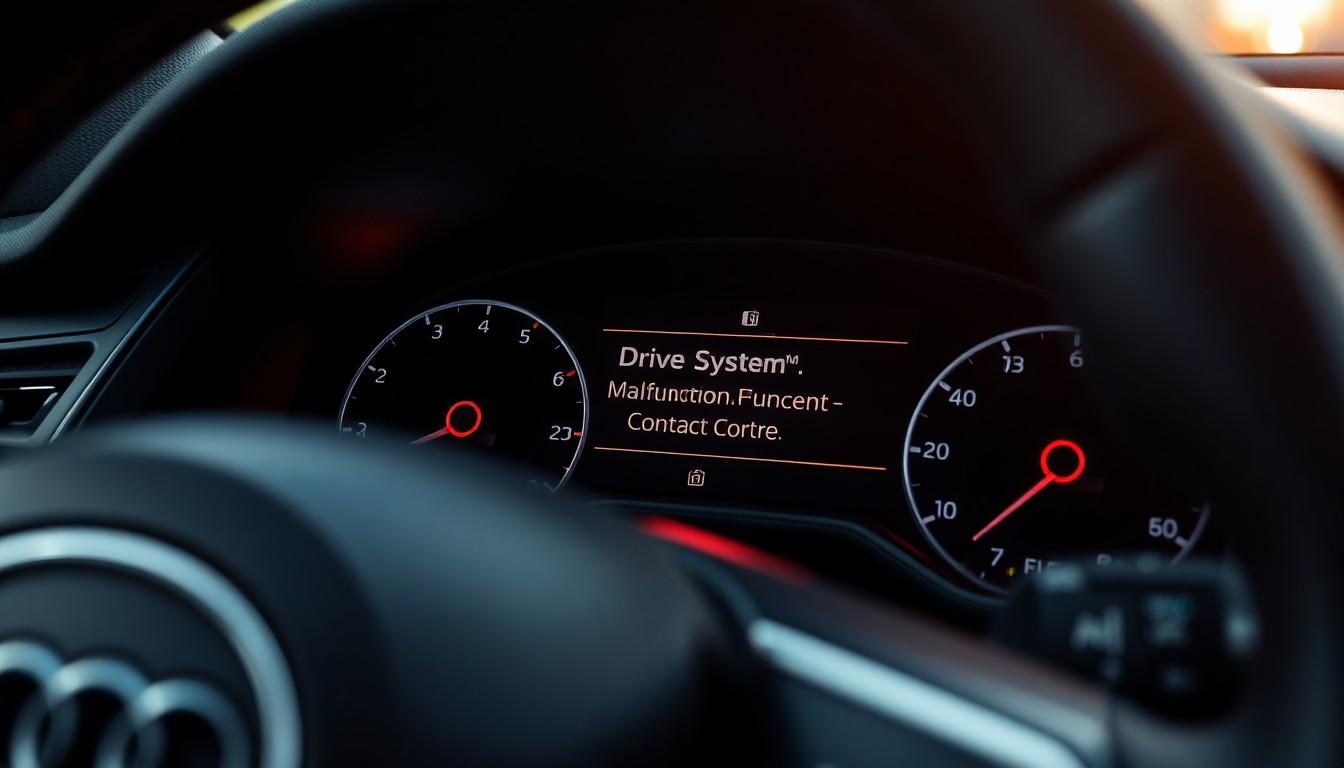Facing a “Drive System Malfunction” alert in your Audi can instantly transform a smooth drive into a stressful situation. This warning typically indicates an issue with your vehicle’s drivetrain components – potentially affecting everything from transmission performance to overall vehicle stability.
We’ve helped thousands of Audi owners navigate this concerning message, and we’ll guide you through understanding what causes this malfunction, the steps to diagnose it, and potential answers. Whether you’re experiencing reduced power, limited functionality, or complete system failure, our comprehensive breakdown will help you get your luxury vehicle back on the road without unnecessary dealer markups.
Understanding Drive System Malfunction in Audi Vehicles
The “Drive System Malfunction” warning on your Audi’s dashboard indicates a problem with one or more components of the vehicle’s drivetrain system. This alert specifically points to issues affecting the proper functioning of your car’s driving mechanics, potentially compromising your safety and vehicle performance. Most Audi models, including the A3, A4, A6, Q5, and Q7, can display this warning when electronic control units detect abnormalities in the drive system operation.
Many Audi owners first notice this warning accompanied by limp mode activation, where the vehicle automatically restricts performance to prevent further damage. The warning typically appears as a yellow or red triangle with an exclamation mark on the dashboard, alongside a text message stating “Drive System Malfunction.” In newer Audi models equipped with virtual cockpit displays, the warning might appear as a pop-up notification with more detailed information about the exact issue.
Several key components can trigger this warning when they malfunction, including the transmission control module, mechatronic unit, wheel speed sensors, and electronic stability control systems. For example, a faulty mechatronic unit often causes jerky gear shifts or complete transmission failure, while damaged wheel speed sensors lead to erratic electronic stability control behavior, both resulting in the drive system malfunction alert.
Modern Audi vehicles feature highly integrated drive systems with multiple electronic control units communicating through a CAN (Controller Area Network) bus system. When one component fails or communications break down between these units, the main control module triggers the warning to alert the driver. This intricate electronic architecture makes proper diagnostic equipment essential for accurate troubleshooting rather than relying on guesswork.
Common Causes of Audi Drive System Malfunctions

Audi drive system malfunctions stem from various issues affecting the vehicle’s complex drivetrain components. Several factors contribute to these problems, ranging from electrical failures to mechanical breakdowns in critical systems. Let’s examine the most common causes that trigger the dreaded “Drive System Malfunction” warning in your Audi.
Transmission Control Module Issues
Transmission control module (TCM) problems frequently trigger drive system malfunction warnings in Audi vehicles. The TCM serves as the brain of your transmission system, managing gear shifts and monitoring various transmission functions. When this module fails, it disrupts normal transmission operation, creating erratic shifting patterns and potentially causing complete system failures. Electrical shorts, software glitches, or physical damage to the module can all compromise its functionality, resulting in communication breakdowns with other vehicle systems that activate the malfunction alert.
Mechatronic Unit Failures
Mechatronic unit failures represent a important source of drive system malfunctions in Audi models. This sophisticated component combines hydraulic and electronic functions to control the transmission’s operation. Symptoms of mechatronic failure include jerky gear transitions, delayed response during acceleration, and unexpected shifts into neutral while driving. The unit contains many sensors, solenoids, and control elements that work together to ensure smooth transmission performance. Fluid contamination, electrical problems, or mechanical wear can cause this critical component to malfunction, triggering system warnings and potentially placing the vehicle in limp mode for protection.
Wiring and Connection Problems
Wiring and connection problems often underlie Audi drive system malfunctions, particularly in older models or vehicles exposed to harsh environments. Frayed wires, corroded connectors, or loose connections disrupt the electrical signals necessary for proper system function. These electrical issues can affect sensors, control modules, and communication networks throughout the drivetrain. Damaged wiring harnesses or faulty ground connections frequently cause intermittent problems that prove challenging to diagnose. Environmental factors like moisture intrusion or heat exposure accelerate the deterioration of these electrical components, creating resistance changes that confuse the vehicle’s sensitive monitoring systems and trigger malfunction warnings.
Warning Signs of Audi Drive System Problems

Recognizing the early warning signs of Audi drive system problems can prevent minor issues from developing into costly repairs. These indicators typically manifest in two main categories: dashboard alerts and noticeable performance changes.
Dashboard Warning Lights
The most obvious sign of an Audi drive system malfunction is the illumination of exact warning lights on your instrument panel. A “Drive System Malfunction” or “Drive System Fault” message prominently displayed on your dashboard serves as a clear indication that something’s wrong with your vehicle’s drivetrain components. This warning typically appears alongside a yellow or red triangle with an exclamation mark, signaling the severity of the issue. Many modern Audi models feature sophisticated monitoring systems that detect problems before they become catastrophic, making these dashboard alerts crucial early warning mechanisms.
Performance Changes and Symptoms
Your Audi communicates drive system problems through various performance changes you’ll notice while driving. Sudden power loss or reduced acceleration capability often indicates a serious drive system malfunction requiring immediate attention. Strange noises such as knocking or thunking sounds during acceleration or deceleration frequently point to mechanical issues within the drive system components.
Unusual vibrations or shaking throughout the vehicle commonly result from engine misfires or transmission problems that compromise the drive system’s integrity. Slipping gears or difficulty maintaining proper gear engagement reveals potential transmission issues that affect the overall drive system performance.
Delayed throttle response or sluggish acceleration suggests problems with either the electronic throttle system or transmission control module. Changes in normal driving dynamics, including inconsistent acceleration or deceleration patterns, indicate underlying drive system malfunctions that compromise vehicle handling and safety.
Additional symptoms include visible fluid leaks beneath your vehicle, burning odors emanating from the engine or transmission area, resistance when steering, and fluctuations in overall vehicle performance. Engine misfires, where one or more cylinders fail to fire properly, can also trigger drive system failure messages in various Audi models.
Diagnosing Drive System Malfunctions in Audi Models

Accurate diagnosis of drive system malfunctions in Audi vehicles requires systematic investigation of multiple components and systems. These malfunctions stem from various issues including engine misfires, low transmission fluid, faulty sensors, electrical problems, mechanical failures, software glitches, and turbocharger issues.
Potential Causes of Drive System Malfunctions
Engine misfires frequently trigger drive system failure messages when one or more cylinders malfunction, causing noticeable engine vibration. Low transmission fluid levels can lead to overheating and transmission system failures, compromising overall drive performance. Faulty wheel speed sensors and other sensing equipment often send incorrect data to the vehicle’s computer systems, triggering warning messages. Electrical problems within Engine Control Units (ECUs) or wiring harnesses commonly disrupt normal drive system operation, especially in older Audi models. Mechanical issues affecting the transmission, driveshafts, or differential represent common physical failures requiring immediate attention. Software glitches occasionally cause false warnings even though no physical component issues. Turbocharger problems, particularly electrical failure of the waste gate actuator, can trigger drive system fault messages in turbocharged Audi models.
Self-Diagnosis Using VAG-COM
VAG-COM diagnostic tools offer Audi owners limited but valuable self-diagnosis capabilities before seeking professional help. Scanning for trouble codes provides essential insights by retrieving Diagnostic Trouble Codes (DTCs) stored in the vehicle’s computer systems, pointing to exact problem areas requiring investigation. Basic system checks through VAG-COM let owners examine fundamental functions in engine, transmission, and electrical systems to identify obvious issues. Understanding the codes and their implications helps owners make informed decisions about whether professional service is needed immediately.
Professional Diagnostic Procedures
Professional diagnosis incorporates sophisticated tools and methodologies to pinpoint exact causes of drive system malfunctions. Technicians first analyze diagnostic trouble codes by performing comprehensive system scans to identify exact problem areas needing detailed investigation. Examination of sensors and wiring follows, with experts meticulously inspecting all drive system sensors and electrical connections for signs of damage or malfunction. Evaluation of the fuel delivery system ensures all components function correctly, as fuel delivery problems can manifest as drive system issues.
Technicians thoroughly inspect the ignition system to detect any firing irregularities that might contribute to drive system warnings. Scrutiny of transmission and exhaust systems involves detailed examination of transmission components and exhaust functionality to identify potential faults affecting overall drive performance. Comprehensive diagnostic tools at authorized service centers enable technicians to check for low transmission fluid, faulty sensors, electrical problems, mechanical issues, and software glitches with precision. Once identified, technicians perform necessary repairs or component replacements to resolve the drive system malfunction effectively.
Preventative Maintenance
Regular maintenance significantly reduces the risk of experiencing drive system malfunctions in Audi vehicles. Adhering to manufacturer-recommended service schedules ensures timely fluid changes, inspections, and software updates crucial for optimal drive system performance. Avoiding aggressive driving habits helps preserve transmission and drivetrain components by reducing stress on these systems. Addressing warning lights promptly prevents minor issues from escalating into major repairs, saving both time and money in the long run.
Repair Options and Costs

Addressing an Audi drive system malfunction involves several repair approaches with varying costs depending on the exact issue. Understanding your options helps make informed decisions when facing this common problem in Audi vehicles.
DIY Answers vs. Dealer Service
DIY approaches for Audi drive system malfunctions are significantly limited due to the complexity of these sophisticated vehicles. Most diagnostic procedures require specialized equipment like VAG-COM or VCDS scanning tools that can properly communicate with Audi’s intricate electronic systems. Attempting repairs without proper diagnostic tools often leads to misdiagnosis and potentially creates additional damage to sensitive electronic components.
Dealer service provides comprehensive diagnostic capabilities with factory-trained technicians who understand Audi’s unique systems. Certified Audi technicians can perform thorough diagnostic checks using manufacturer-exact tools to identify the exact source of drive system malfunctions. Their specialized knowledge proves particularly valuable when dealing with the interconnected electronic control units in modern Audi vehicles. Dealership repairs also maintain warranty coverage and ensure proper documentation of all service work performed on the vehicle.
Repair costs vary substantially based on the underlying cause:
- Engine misfire repairs range from $300-$2,500 depending on whether the issue involves simple spark plug replacement or more complex injector work
- Transmission-related problems typically cost between $1,000-$5,000, with complete transmission rebuilds at the higher end
- Sensor replacements generally fall between $200-$800 including parts and labor
- Electrical system repairs range from $400-$1,200 depending on complexity
- Software updates and control module reprogramming typically cost $150-$500
Replacement Parts Considerations
Genuine Audi parts represent the safest option for drive system repairs, though they come at a premium price point. These components match the original specifications exactly and integrate seamlessly with existing systems. Using genuine parts maintains warranty coverage and ensures the vehicle’s electronic systems will recognize and properly communicate with the new components.
Third-party aftermarket parts offer cost savings but introduce compatibility risks with Audi’s sensitive electronic systems. Some high-quality aftermarket manufacturers produce reliable components, but compatibility issues can arise particularly with electronic parts that must communicate with multiple vehicle systems. Many independent repair shops use a mix of OEM and aftermarket parts to balance cost and reliability.
Refurbished or remanufactured components provide a middle-ground option for budget-conscious repairs. These parts, especially electronic control modules and mechatronic units, undergo professional rebuilding to meet original specifications. Quality varies significantly between suppliers, making it essential to source these components from reputable rebuilders with solid warranties. Certified pre-owned parts from Audi dealerships offer a safer alternative, though at higher cost than independent remanufacturers.
Preventive Maintenance to Avoid Drive System Failures

Regular maintenance prevents most drive system malfunctions in Audi vehicles. Implementing a proactive care routine significantly reduces the risk of experiencing the dreaded “Drive System Malfunction” warning. Our comprehensive maintenance approach addresses the most common failure points identified in Audi’s sophisticated drivetrain systems.
Regular Vehicle Inspections
Professional inspections catch potential drive system issues before they become major problems. Scheduling quarterly check-ups with certified Audi technicians ensures that small issues don’t escalate into costly repairs. These inspections should include comprehensive diagnostic scans that can identify early warning signs not yet visible through performance changes.
Battery Maintenance
Battery health directly impacts drive system functionality in modern Audi vehicles. Maintaining proper battery voltage prevents triggering drive system faults that commonly appear when electrical power fluctuates. Testing battery voltage every six months and replacing batteries every 4-5 years keeps electrical systems functioning optimally, especially in hybrid Audi models where battery pack sensors are crucial components.
Transmission Maintenance
Transmission fluid condition plays a critical role in preventing drive system failures. Checking fluid levels and quality during every service interval protects the complex transmission components from premature wear. Fresh transmission fluid reduces friction and heat buildup that often leads to mechatronic unit failures and subsequent drive system warnings.
Engine Maintenance
Engine performance directly affects drive system health in all Audi models. Addressing engine misfires promptly by replacing worn spark plugs, cleaning fuel injectors, and maintaining fuel delivery systems prevents cascade failures throughout the drivetrain. Regular oil changes with manufacturer-approved lubricants protect engine internals that interface with transmission systems.
Sensor and Electrical System Checks
Electrical integrity preserves drive system communication networks essential for proper operation. Inspecting wiring harnesses, connections, and sensor functionality during maintenance prevents the communication breakdowns that trigger malfunction warnings. Corrosion protection for electrical components extends their lifespan, particularly in areas with harsh weather conditions.
Software Updates
Control module software requires regular updates to prevent known drive system glitches. Ensuring all ECUs (Electronic Control Units) run the latest firmware versions addresses many software-related malfunctions before they appear. Dealership visits for software updates typically take less than an hour but can prevent days of vehicle downtime from system failures.
Addressing Intake System Issues
Intake air integrity affects engine performance and subsequent drive system operation. Checking for vacuum leaks, replacing air filters, and maintaining clean intake passages prevents engine misfires that commonly trigger drive system warnings. Proper airflow management keeps combustion processes optimal, reducing stress on transmission components during acceleration and gear changes.
Audi Model-Specific Drive System Issues

Different Audi models experience unique patterns of drive system malfunctions, with exact components more prone to failure in certain vehicle lines. Let’s examine the most common issues affecting popular Audi models.
A4 and A5 Common Malfunctions
A4 and A5 models frequently display the “Drive System Malfunction – Contact Service” message on dashboards even though the vehicle running normally. Electronic Control Unit (ECU) failures represent a primary cause of drive system malfunctions in these models, often requiring complete replacement to resolve the error. Turbocharger and supercharger problems can trigger system warnings, with faulty boost pressure sensors sending incorrect readings to the vehicle’s computer. Many owners report that these warnings appear intermittently before becoming persistent, making diagnosis challenging without specialized equipment. Cooling system complications, particularly leaking water pumps, can damage solenoid valves and affect vacuum lines, creating cascading failures that manifest as drive system errors.
Q5 and Q7 Drive System Vulnerabilities
Q5 models commonly develop drive system malfunctions due to differential wear from extended use and inadequate maintenance schedules. Transmission component deterioration in the Q5 leads to power transition problems, triggering malfunction alerts when shifting becomes compromised. Unusual grinding noises from the undercarriage often indicate important differential damage requiring immediate attention. Q7 SUVs share many vulnerability points with the Q5, including susceptibility to general drivetrain wear affecting engines, transmissions, driveshafts, and differentials. Regular servicing proves critical for these larger Audi models, as their increased weight puts additional strain on drive components. Replacement of worn parts typically resolves these issues, though costs can be substantial depending on the exact component affected. Both models benefit from preventative maintenance that addresses potential ECU, turbocharger, and boost pressure sensor issues before they trigger system-wide failures.
Conclusion
Addressing an Audi drive system malfunction requires both knowledge and prompt action. We’ve seen how these issues can affect various Audi models differently but eventually compromise safety and performance across the board.
Regular maintenance remains your best defense against these complex problems. Whether it’s keeping transmission fluid fresh or monitoring sensors for early signs of failure your proactive approach can save thousands in repair costs.
Remember that while DIY diagnostics have their place professional assessment often provides the most accurate answers. By understanding the warning signs and maintaining your vehicle according to manufacturer specifications you’ll enjoy a more reliable driving experience and extend the life of your Audi’s sophisticated drive system.
Frequently Asked Questions
What does the “Drive System Malfunction” warning mean in an Audi?
The “Drive System Malfunction” warning indicates a problem with your Audi’s drivetrain components. It appears as a yellow or red triangle with an exclamation mark on the dashboard, alerting you to issues that could affect transmission performance and vehicle stability. This warning typically activates limp mode, which restricts performance to prevent further damage to your vehicle.
Which Audi models commonly experience drive system malfunctions?
This warning can appear in various Audi models, including the A3, A4, A6, Q5, and Q7. The A4 and A5 models often display the “Drive System Malfunction – Contact Service” message due to ECU failures and turbocharger problems, while Q5 and Q7 models are more prone to differential wear and transmission component deterioration.
What components can trigger a drive system malfunction warning?
Key components that can trigger this warning include the transmission control module (TCM), mechatronic unit, wheel speed sensors, and electronic stability control systems. A faulty mechatronic unit may cause jerky gear shifts, while damaged wheel speed sensors can lead to erratic stability control behavior. When these components fail or communication breaks down, the main control module triggers the warning.
What are the early warning signs of Audi drive system problems?
Early warning signs fall into two categories: dashboard alerts and performance changes. Look for warning lights, sudden power loss, strange noises, unusual vibrations, slipping gears, delayed throttle response, and visible fluid leaks. Recognizing these symptoms early can prevent minor issues from escalating into costly repairs and maintain your vehicle’s safety.
Can I diagnose a drive system malfunction myself?
Limited self-diagnosis is possible using VAG-COM diagnostic tools to scan for trouble codes and check basic functions. However, due to Audi’s complex electronic architecture, professional diagnosis is recommended. Technicians use advanced tools to analyze trouble codes, inspect sensors and wiring, and thoroughly check ignition, transmission, and exhaust systems for accurate diagnosis.
How much do Audi drive system repairs typically cost?
Repair costs vary widely based on the specific issue. Engine misfire repairs range from $300 to $2,500, transmission-related problems cost between $1,000 and $5,000, and sensor replacements generally fall between $200 and $800. The choice between genuine Audi parts, aftermarket options, or refurbished components will also affect the final cost.
Should I use genuine Audi parts or aftermarket alternatives for repairs?
Genuine Audi parts ensure compatibility and maintain warranty coverage but come at a premium. Aftermarket parts offer cost savings but may introduce compatibility risks. Refurbished or remanufactured components from reputable suppliers offer a middle ground, balancing quality and cost. Your decision should weigh budget constraints against reliability needs.
How can I prevent drive system malfunctions in my Audi?
Prevent drive system failures through regular maintenance including vehicle inspections with certified Audi technicians, battery maintenance, transmission fluid checks, engine maintenance, sensor and electrical system checks, and software updates. Follow manufacturer-recommended service schedules, avoid aggressive driving habits, and address warning lights promptly to reduce malfunction risks and save on potential repair costs.







